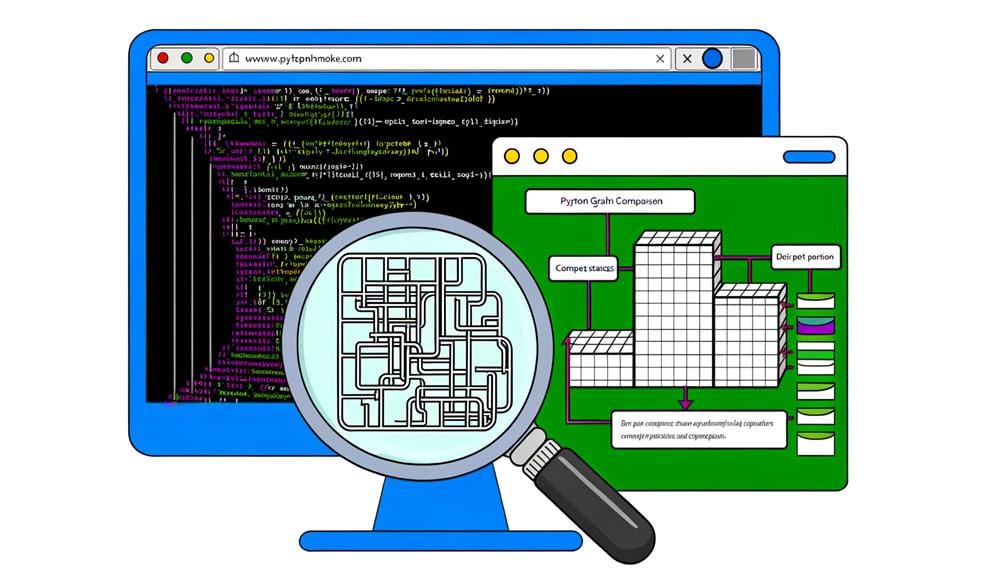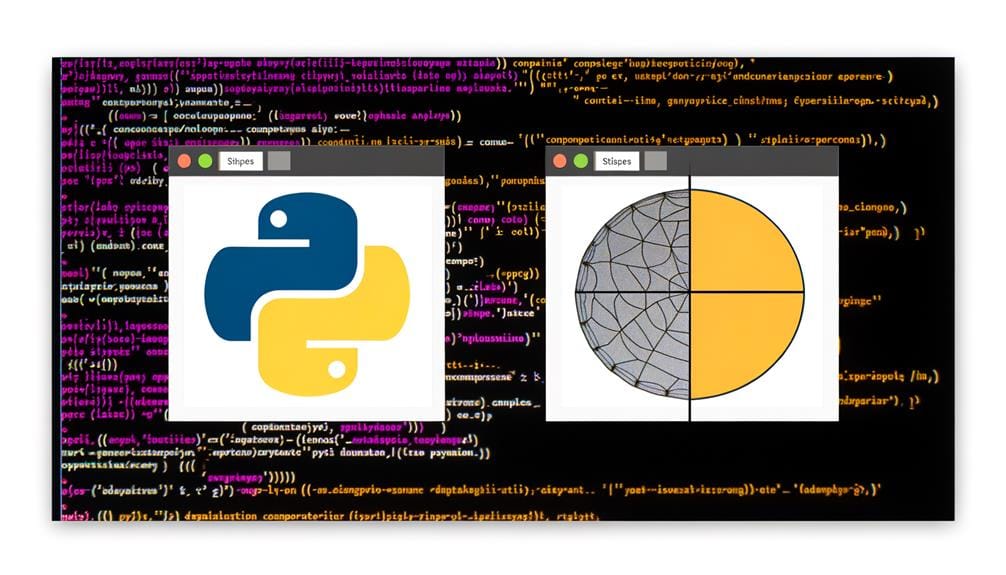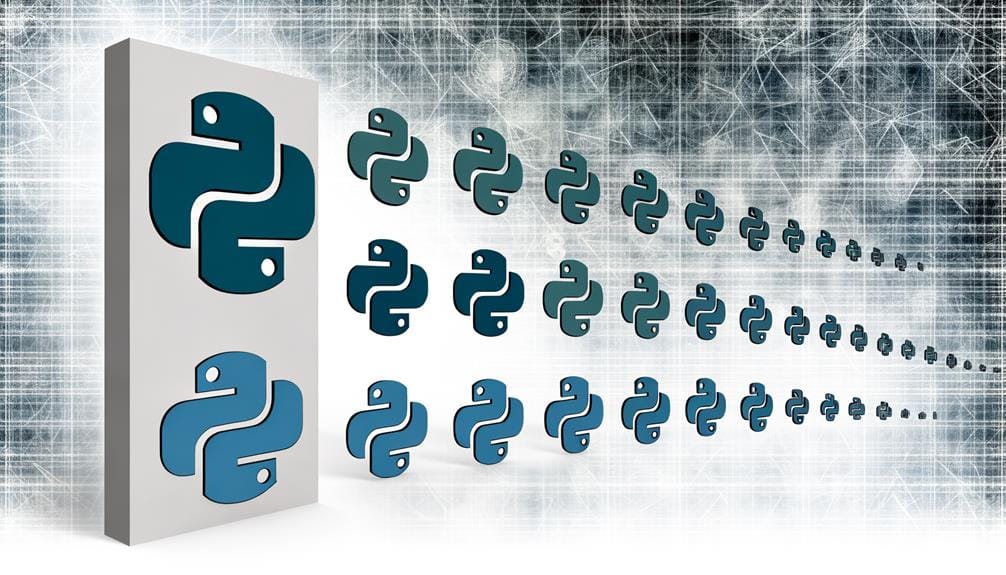To perform a content analysis using sitemaps via Python, we start with data preparation using pandas. Then, we use Python libraries to crawl and analyze the sitemap, categorizing and visualizing the content. This gives an understanding of the website's content structure. For richer insights, we can also explore competitor's content structures using similar methods. Python's analytical strengths allow us to detect potential spam patterns and investigate the impact of automated updates. Using Python for trend analysis and data visualization, we extract actionable insights to inform content strategy. Trust us, there's much more to uncover by persisting with Python.
Key Takeaways
- Utilize Python libraries like Beautiful Soup or Scrapy to crawl and analyze sitemaps.
- Extract vital sitemap information to understand the website's content structure and categorization.
- Implement content grouping methods to cluster similar content for easier analysis.
- Apply Python's analytical capabilities to detect potential spam indications in update frequency.
- Use data visualization tools like Matplotlib to graphically represent sitemap data for better understanding.
Data Preparation and Exporting
In our journey of content analysis, the first vital step is preparing and exporting the data, using Python to convert instances into Date Time format, resample them annually, and organize them into a frame that's ready for further analysis. We utilize pandas, a powerful Python library, to do this efficiently. We first convert our data instances into Date Time format using the pd.to_datetime method. Next, we resample our data annually using pandas' in-built resample function. We then organize our data into a data frame, ready for further manipulation and analysis. Finally, we export our prepared data as a CSV file, sans the index column. The final step is visualizing our data, and for this, we employ various visualization techniques to better comprehend our content publishing trends.
Sitemap Crawling and Analysis

Now that we've prepared our data, let's tackle the process of crawling and analyzing sitemaps to understand a website's content structure and its distribution. We'll use Python's robust libraries to crawl the sitemaps and extract vital information. Analyzing this data provides insights into the website's content hierarchy and its distribution across various categories. By applying content categorization methods, we can group similar content together, making our analysis more efficient and revealing patterns we might have missed otherwise. Additionally, sitemap visualization techniques offer a graphical representation of this data. These visuals can highlight imbalances in content distribution, reveal gaps in the content structure, and guide us in optimizing the website for better user navigation and SEO performance.
Competitors Content Structure Exploration

Ever wondered how we can delve into a competitor's content structure and uncover their strategy? We can leverage Python to perform a competitor ranking analysis and content depth assessment.
Here's our approach:
- First, we scrape the competitor's sitemap data using Python libraries like Beautiful Soup or Scrapy.
- Then, we analyze the sitemap URLs to understand content categorization.
- We evaluate the frequency and timing of content updates to assess their content strategy.
- Next, we perform a deep-dive analysis into the topics and keywords that the competitor is focusing on.
- Finally, we use this data to inform our own content and SEO strategy.
With Python at our disposal, exploring a competitor's content structure becomes a straightforward, data-driven process.
Detecting and Understanding Spam

As we dive into the realm of spam detection, it's crucial to grasp the concept of regular updates in the lastmod column and how they could signal potential spammy behavior. Understanding spam signals involves recognizing patterns that deviate from standard updating practices. Our spam detection techniques leverage Python's analytical capabilities to discern these patterns.
Consider this table:
| lastmod Update Frequency | Potential Spam Indicator |
|---|---|
| Very Frequent | High |
| Frequent | Medium |
| Average | Low |
| Infrequent | Very Low |
| Rare | Negligible |
High frequency updates might indicate spammy tactics, while rare updates are typically benign. Remember, though, that correlation doesn't imply causation, so further analysis is necessary to confirm spam.
Impact of Automated Updates

Delving into the realm of automated updates, we must consider their potential impact on search engine behavior and the possible repercussions on our website's visibility. Uncontrolled updates can lead to consequences, both in terms of search engine rankings and user experience.
- Automated updates can disrupt the website's structure, making it hard for search engines to crawl and index pages.
- Continuous changes can cause fluctuations in search engine rankings.
- Unplanned updates might introduce errors into the sitemap, affecting the website's visibility.
- Excessive updates may be interpreted as spamming attempts by search engines, resulting in penalties.
- On the other hand, well-planned automated updates can ensure fresh content, boosting our search engine performance.
Thus, we need to strike a balance, implementing updates that enhance, not hinder, our site's visibility.
Insight Generation Techniques

While striking a balance with automated updates is vital, we can further enhance our website's visibility through effective insight generation techniques. By leveraging Python's powerful data manipulation and trend analysis capabilities, we're able to discern patterns and behaviors in our sitemap content. We make use of data visualization tools like Matplotlib to graphically represent our findings. This allows us to visually interpret data trends, making it easier to identify anomalies or areas for improvement. Moreover, Python's extensive libraries facilitate the handling of large datasets, ensuring that our insights are based on comprehensive data. Remember, these techniques aren't just about finding patterns; they're about deriving actionable insights to drive strategic content decisions.
Comparative Content Trends Analysis

In order to gain a comprehensive understanding of our website's performance, we're diving into a comparative content trends analysis, leveraging Python's robust capabilities for parsing and manipulating our sitemap data. Our focus is on:
- Identifying and analyzing our sitemap data, using Python to parse and convert it into actionable insights.
- Conducting a thorough competitor comparison, examining their sitemap data and comparing it to ours, to identify potential areas for improvement.
- Implementing trend analysis, allowing us to track content performance over time and adjust our strategy accordingly.
- Using Python for detailed data visualization, aiding in the interpretation and presentation of our findings.
- Finally, leveraging our findings to optimize our website's content, ensuring it remains competitive and relevant.
Implementing Content Analysis Strategies

Building on our understanding of content trends, we're now set to implement content analysis strategies using Python, aiming for sharp insights that can drive our content optimization efforts. By dissecting URL structures and categorizing content, we can pinpoint areas ripe for keyword optimization.
Here's a glimpse of our approach:
| Strategy | Python Method | Outcome |
|---|---|---|
| Content Categorization | Parsing URL structures | Improved Keyword Optimization |
| User Engagement Analysis | Data Visualization | Enhanced User Experience |
| Content Pruning | Organic Traffic Analysis | Streamlined Content |
Through these strategies, we not only enhance user engagement but also streamline our content, making it more appealing to both users and search engines. Using Python, we turn raw data into actionable insights, setting the stage for successful content marketing strategies.
Frequently Asked Questions
How Can I Automate the Sitemap Crawling Process With Python?
We're always looking for ways to boost our crawling efficiency optimization. Automating the sitemap crawling process with Python presents some integration challenges, but it's doable. We'd start by building a Python script to fetch and parse the sitemap. Then we'd extract the URLs and use them for data collection. Lastly, we'd schedule the script to run automatically. This way, we're streamlining our process while overcoming Python integration challenges.
What Specific Tools or Libraries in Python Are Ideal for Content Analysis?
We're big fans of Python's compatibility with SEO, especially when it comes to content analysis. The BeautifulSoup library is a game changer. It allows us to parse HTML and XML documents, making sitemap navigation a breeze. We're able to dissect, analyze and understand content like never before, all while keeping our code clean and pythonic. The insights we gain are invaluable, helping to shape our content strategy effectively.
Can I Use Python to Detect Spam in Other Areas Beyond the Lastmod Column in Sitemaps?
Absolutely! Python's versatility allows us to use spam identification techniques beyond just the lastmod column in sitemaps. We can analyze other elements like URL structures, metadata, and keyword frequency. It's also possible to use Python to apply machine learning algorithms for more advanced spam detection. Remember, spam can exist in many forms on a website, so it's important to examine all areas thoroughly.
How Can I Quantify the Impact of Automated Updates on Search Engine Visibility?
We're on a mission to quantify the impact of automated updates on search engine visibility. By monitoring changes in traffic and rankings, we can measure the effects directly. With Python, we're diving into the data, stripping it back to bare bones. It's not just about visibility optimization, but understanding the ripple effects of our actions. Through rigorous analysis, we're unmasking the hidden impacts, ensuring our content shines brightest in the vast digital cosmos.
Are There Any Limitations or Challenges When Performing a Comparative Content Trend Analysis?
We're often confronted with data interpretation challenges when performing comparative content trend analysis. Limitations include inconsistent data categorization across different sites and the potential for misinterpretation of trends. There's also the issue of varying content update frequencies which can skew comparisons. Despite these challenges, we're confident that with careful methodological design and thorough data validation, these limitations can be mitigated.



